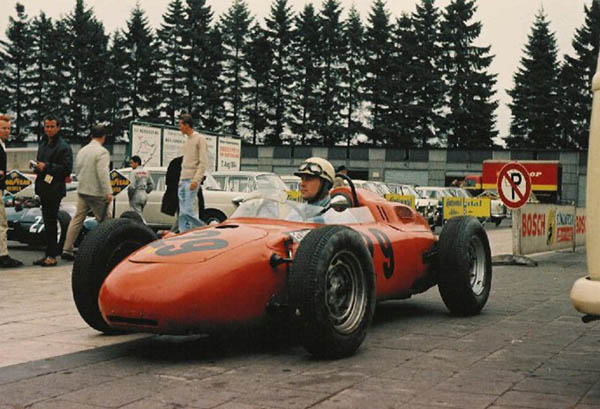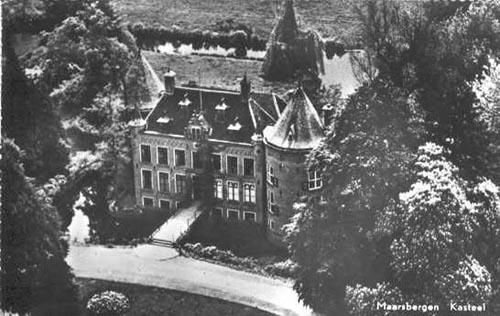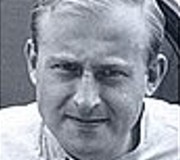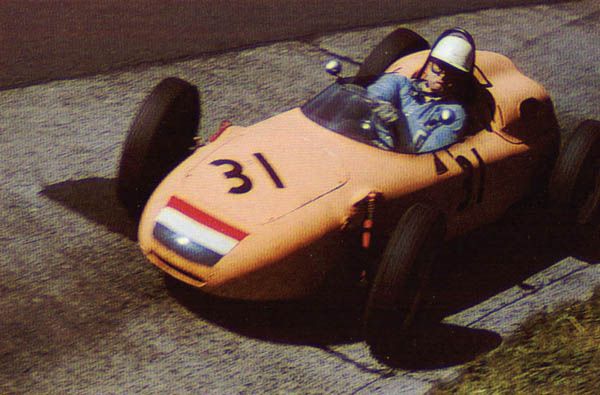
Count Carel Antoni Pieter Jan Hubertus Godin De Beaufort, often described as ‘the last of the gentleman drivers’ or ‘last of the true F1 amateurs’, came from a very wealthy and aristocratic background. One would not want to antagonise his family by risking posting anything defamatory so with that in mind…
I’m now going to indulge in a paragraph completely unrelated to the subject. Got that? Completely unrelated. British readers may recall TV comedy sketch show “The Fast Show”, that was briefly popular back in the 1990s. One of its many recurring characters was ‘office joker’ Colin Hunt, a colourfully-dressed man who believed himself to be wacky, fun and truly hilarious, when in reality all of his colleagues thought he was crass, unfunny, tedious and an annoyance that did nothing but get in the way of their work. Now, back to the completely unrelated Carel de Beaufort.
Born in privilege in a huge mansion in Holland called Maarsbergen, Carel’s penchant for ‘hilarious’ jokes started in his youth, when he used a rubber cable to tie the car of two magistrates who had come to visit his father to a tree. Inevitably, when the car was started, and the two men tried to drive off, the car rebounded into the tree at speed. Both men suffered minor injuries, but this story is frequently used as an example of de Beaufort’s ‘unique’ character and sense of humour. The only boy, and heir to his family’s titles, he was frequently indulged both emotionally and financially by his mother to whom he was close all his life.

After crashing various road cars – after all, he had the money to just buy another one – both on his large estate (at one point seeing if a VW Beetle would squeeze under a trailer; it couldn’t), and on the public roads, during his late teens, de Beaufort got a taste for fast driving, and graduated to sports car racing in the 1950s. Here, another incident indicative of his character was seen. The AVUS track was perhaps one of the most ludicrous motorsports venues there has ever been – two flat-out straight sections of Autobahn, connected by a hairpin at one end, and a fearsome banked turn at the other. The banking was utterly unprotected at the top, meaning that in the event of an accident, you were going over, and into the trees below.
This is exactly what happened to de Beaufort, who lost control of his Porsche, and flew over the top in the 1959 race. Whilst most spectators assumed the worst, the car had miraculously had its fall broken by branches, and not only that, but landed on its wheels. The lucky escape was such that the Dutchman was able to drive his car back onto the circuit (albeit his vehicle now in a state of some disrepair) to the astonishment of the crowd, many of whom thought that they were seeing a ghost.
The story doesn’t end there however, because later the same day, the dynamic and exciting French driver Jean Behra was not so fortunate. Behra lost control of his own Porsche on the same banking, and was thrown from the car. His body impacted a huge flagpole with enough force to knock it over, and thus Behra stood no chance, dying from massive head and chest injuries. The scene was later cordoned off by the authorities such that the fatal accident could be investigated as per German law. This was of no concern to de Beaufort, who had been busy talking to every available journalist about his own miracle escape, and he brazenly pushed the cordon aside to pose for smiling photos just yards from the scene of Behra’s death and wrecked vehicle. The remainder of the drivers at the track voted with their feet, and walked away in disgust.
By this time, however, de Beaufort had already made his F1 debut, and a reputation among the sport’s true stars such as Fangio and Moss. The reputation was not favourable. After a forgettable outing in 1957, driving in a Formula Two race running concurrently with the German GP, he made his F1 debut proper at his native Zandvoort track in the 1958 Dutch Grand Prix. He qualified, and finished last, 6 laps down on the winner, Stirling Moss. In the race he was seen as something of a mobile chicane, and not too keen to let the leaders lap him. Arriving at a corner to find de Beaufort in the way was something the leaders encountered time after time. “Bloody silly” is how Stirling Moss described the Dutch Count’s driving style. 1959 saw another F1 entry into his home race, another last row start, another last place finish, this time 7 laps down.

Keen to spread his wings in F1 outside Holland, de Beaufort bought a ride in a Maserati for privateer team Scuderia Ugolini for the 1959 French GP. This was to be his only F1 race in which he didn’t use his own Porsches. Over a 5-mile track, de Beaufort’s qualifying time was SIXTEEN seconds off pole, and he finished 10 laps down, breaking his own record hitherto for distant finishes. The team didn’t employ him again.
His next outing at 1960’s Dutch Grand Prix conformed to the ‘qualified last, finished last’ pattern, and then de Beaufort headed off to Belgium for the race there. The only problem was that, while the Dutch race organisers were happy for the Count to enter his home race to provide some local interest, the Belgians had no such incentives, and having seen de Beaufort’s performances up until now, had made it clear in the build-up that he was not welcome.
Never mind! De Beaufort turned up anyway, got onto the track and did some laps before he was spotted – as ever holding faster cars up – by then World Champion Jack Brabham. A furious Brabham remonstrated with the race organisers, who duly black-flagged the Dutchman. De Beaufort saw his disqualification, but decided to go for another lap anyway. Such larks! Again, however, the comedy act was out of mood with the times. The race weekend remains one of the most tragic in motorsport history – and definitely the worst weekend ever for British motorsport. There were serious injuries in practice for both Stirling Moss and Mike Taylor (whose wrecked car was not found for over 30 minutes), and during the race itself both Alan Stacey, and the immensely promising Chris Bristow were both killed in separate accidents – the only time that two drivers have been killed in the same F1 race. De Beaufort’s jolly japes were all well and good, but motor racing was a serious and at times deadly business.
For 1961, de Beaufort replaced his car with a faster Porsche 718, and after some wangling, convinced most race organisers to let him enter their races. Painting his car a bright orange for Holland, at least you couldn’t miss him. De Beaufort also had the rather unusual habit of driving in bare feet, not something that you’d do in an open cockpit if you suffered from bad circulation.
He achieved the heady heights of finishing a personal best of second last in his home race in the new car (a race notable for the fact that there were no retirements or pit stops in the entire field – and they say some races nowadays are dull). For the rest of the year, he largely traipsed around at the back, finishing effectively last in Belgium and Britain, although the power of his new car helped him to a creditable 7th place at the relatively undemanding, mostly flat-out circuit of Monza in Italy.
1962 was the high watermark. At his fifth attempt at his home race, de Beaufort did something very unusual for drivers in this ’20 worst’ series, and scored his first – and his country’s first – F1 championship point, for 6th. He was aided, of course, by the fact that 13 of the 22 entered cars retired, and that additionally Jim Clark had mechanical problems, but it still means that he beat two other drivers, including Jo Bonnier in a similar machine. He was nonetheless 4 laps down at the end, however.
After being brought back down to Earth with a bump by failing to qualify in Monaco, there were then middling, semi-creditable performances in Belgium, and France, the latter seeing another point for 6th place, albeit 3 laps off of the leaders. There was little doubt that the aristocrat had improved, but he was still hardly threatening the likes of Clark and Hill. The rest of the year rather petered out, with de Beaufort finishing 6 laps down in Britain and 5 in Italy, and rather wasting the cost of transporting his tangerine machine to the USA by stuffing the car into the scenery on the 9th lap.

It must be said that the crash was uncharacteristic – de Beaufort had gained the nickname Veilige Careltje (‘Safe Little Carel‘) for his circumspect driving over the years. For de Beaufort, it was the taking part – and having fun on the way – that counted. This was reflected in his ballooning weight, with photos of de Beaufort from 1963 onwards showing a figure that was a far cry from the athletes of the modern sport.
By 1963, a combination of the technology improving, and the Dutchman’s weight issues had let to his car becoming under-powered and thus less competitive, and he reverted to his usual position as a backmarker. Remarkably, he scored another couple of points, in Belgium and the USA, but this was more by default, as there were only 6 cars running at the end of both races, and the last in both was ‘Veilige Careltje ‘, circumspectly coming home 10 laps down in the US, a result that would today have him down as ‘non classified’ for being too far behind.
Again, his general attitude towards racing was shown at the 1963 French race at Reims. When official practice had finished, it was noted that de Beaufort and his orange Porsche were missing. Fearing an accident, race organisers sent out a search team, only to find that de Beaufort had stopped at the back end of the circuit to pick up an attractive female spectator, and to give her a ride round the track….
By 1964, the little Porsche was almost completely obsolete, and de Beaufort decided he would enter only two races, on his ‘specialist’ tracks of Zandvoort in Holland and the Nurburgring in Germany. In Holland, he qualified nearly nine seconds off the pace, and thankfully for the leaders, retired early on with mechanical troubles.
And so it was on to the Nurburgring for the sixth race, where Carel had, remarkably, been previously employed to do some motorsport instruction. Certainly, he knew the circuit like the back of his hand, and – with more cars entered than could start – would have to conjure up all of his tricks to qualify his elderly Porsche for the race. Having done some reconnaissance laps wearing a Beatles wig – much to the ire of the championship contenders for whom the dangerous track was no laughing matter – de Beaufort set out to work. The track and the sport, however, this time, bit back.
On the approach to Bergwerk, near where Niki Lauda had his terrible flaming crash some 12 years later, de Beaufort’s tiny car skidded, probably on some oil. The car careered off the road, and down the embankment. de Beaufort was thrown from the car, and in a tragic reminder of Behra’s accident 5 years before, his hefty frame collided square-on with a tree.
Despite the best efforts of his personal physician, flown to the scene straight away, and doctors in nearby Koblenz, de Beaufort succumbed to his injuries on Sunday night, just after the race itself. He was 30 years old. Had he lived, he would have been paralysed, and given his ‘wine, women and song’ playboy nature, perhaps it was for the best that he never had to endure this restriction.
Unquestionably a dilettante, and an amateur, de Beaufort did produce a couple of reasonable performances in the middle of the 1962 season, and does have 4 World Championship points to his name, but there is little doubt that he would not get anywhere near the F1 of today. Was he a throwback to a more innocent era, a man who competed purely for the love of the sport, who saw the sport as the fun it should be, and who eventually proved his worth by scoring his nation’s first championship points? Or was he a fish out of water, a wealthy, cold and arrogant playboy who had no right to be on the track against serious competitors, and who was an active danger due to his frequent blocking tactics and madcap antics? As ever, the truth is probably somewhere in the middle. What we can say, however, is that we will almost certainly never see his like again.